Earlier this week, I visited Stonehenge and Salisbury Cathedral. Both structures evoked a sense of wonder and historical perspective.
Stonehenge (properly pronounced Stone-HENGE, with the accent on the second syllable) sits about an hour and a half from London proper. The massive stones rise, silent and imposing, on top of a hill, quite visible from the secondary highway that passes close by.
Despite ample pursuit of their origins over the years, they still defy explanation. Someone built a first circle of timbers near that spot around 5,000 years ago, digging out ditches with deer antlers and other crude tools. A thousand years later, someone else brought many of the stones we see today from 150 mi (240 km) further north in Wales. Floated on a huge raft down the coast? Brought upriver the same way? Rolled on logs up the hill? The stones weigh between 20 and 50 tons each. With today’s huge trucks and hydraulic lifts, the feat would be impressive. That they managed the move when folks were digging with deer antlers is unfathomable.
Some say the stones stamped a political statement on the crest of the hill. Come this way and face our power. Others suggest they followed a religious impulse, an offering of reverence, an appeasement to the gods who controlled the builders’ world, or a glorified burial space.[1] Still others imply they might have had a more scientific purpose in mind. Some link Stonehenge to Druid worship but, by the time the Druids emerged, the site would have already lain in ruins for over a thousand years. Constructed in line with equinoxes and solstices, the site did most certainly help track the seasons and movements of stars. Again, though, no one knows for certain exactly why—and it’s likely to stay that way.
Salisbury Cathedral came quite a bit later in time, but still ages ago. Constructed in an astonishing 38 years during the 13th century—when most cathedrals took more than a full century to complete—it has stood as a testament to the grandeur and sweeping architecture of the Gothic period.
Thin marble pillars reach from floor to ceiling, countless detailed figures adorn the outside, and the tallest church spire in Europe reaches skyward for more than 400 feet.
The inside still serves as a place of worship but also houses two remarkable pieces of history: the oldest clock in the world and the Magna Carta, the 13th-century document that heralded in the idea of human rights above the power of monarchies and other governments. Everywhere you turn in the cavernous building, you see history. You see effort.
Those who have read earlier posts like this one or this one can probably predict that I had a much greater rapport with Stonehenge. Sitting next to the grand stones stirred something palpable in me. Their stillness and grace, out in the open air, call out the same in me. They’re connected to the seasons and cycles of stars. They loom in tune with the landscape. I had worried that the swarms of
tourists would diminish the sacredness, but the site’s supervisors have done a fine job preserving the majesty. Each visitor gets her own audio guide—that actually keeps people quiet and allows a more reverential tone.
In contrast, Salisbury seems more a monument to human power than an homage to God. Yes, I could imagine deep and quiet conversations with an elder monk along the side courtyard. But within and outside the cathedral itself stand dozens of statues of vicars, bishops, barons and governors who served the place.
Plaques along the walls give mention to others buried there over the centuries. Almost all of those names connect to corporate or government power. Elsewhere, though the main cathedral space lifts the eyes upward, it also feels dry and spiritless. Throughout, the place seems meant more to impress or impose than to invite or inspire. I find the former unfortunate at best.
That said, both sites do evoke an historical sense of awe. I found it difficult to even comprehend the ages at play. Stonehenge is in a category all its own. Who had the first vision? Why did they do what they do? But even Salisbury was built in the 1200’s[2]. Again, no machine, no petrol power. Only the craftsmanship and hard work of the hundreds (thousands?) who designed and built the place.
And though they’re hugely different in style and feel, both speak of the boundless creativity of the human spirit. What impulse leads us to create meaningful spaces? What makes us expend such vast energies to honor the ineffable? Why do we shape these places and how do they shape us in return?
I love that such questions endure below the everyday. I love that Stonehenge and Salisbury return them to the surface.
[1] Many other clear burial mounds in the nearby fields and hills surround the stone circle.
[2] I wonder if these dates are tough to grasp partly because I’m American. We tend to think of ourselves as cousin countries with Great Britain. Sure, they had an empire. We became a world power. We’re about even. But history as usually told in the U.S. starts in the late 1700’s, maybe the early 1600’s if we go back to the Pilgrims. That’s a good 400 years after Salisbury was built! We don’t run parallel to the UK—they had layers of history before we even got started.
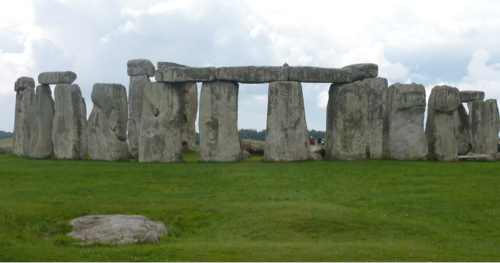
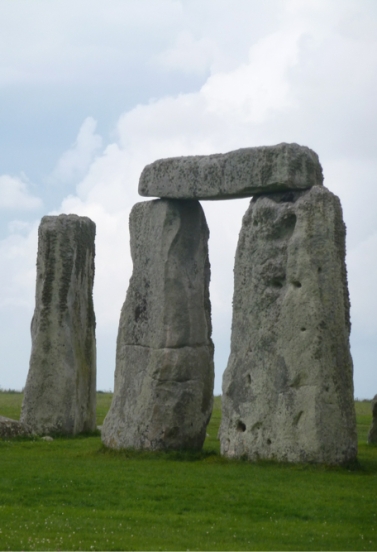
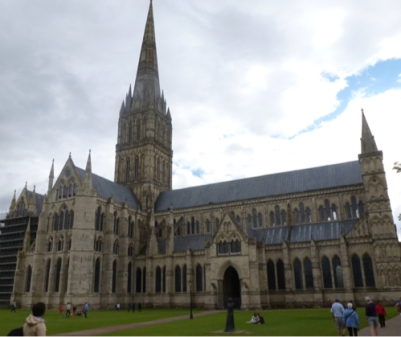

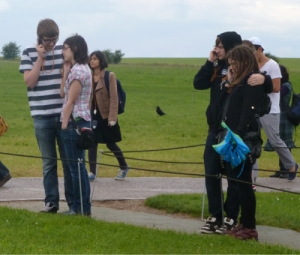
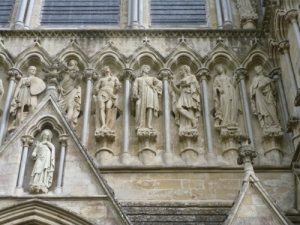
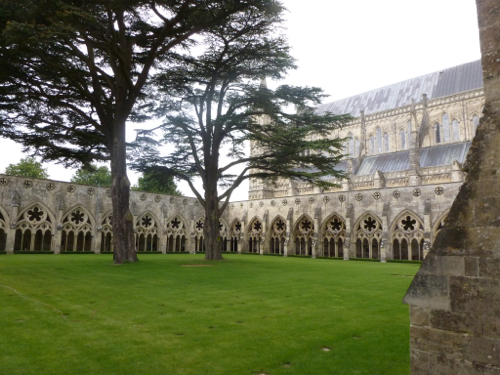

I may have to do several comments…
I think a key thing for Stonehenge is *why* they were tracking the movements of the sun and the stars. The precision of what is built…down to the second relative to capturing the solstice is pretty amazing. And why it is placed there…in the center of where all the crop circles emerge. I am sorry you were not able to go over to Avebury, the other henge there. You can touch and walk up to the stones. They have magnetic fields…that have been clearly measured…and serve as an amplifier.
In the museum there, they also have some fascinating artifacts that suggest a connection to ancient peruvian sites. I suspect that way more is going on at both henges than is on the audio tour material.
Yes, I was a bit disappointed not to visit Avebury, but we had to make choices about how much we could do in any given day–and I needed good time to process what I was taking in. Suggestion well-noted, though. Avebury will rank as a must-see for a next visit. I especially like the idea of getting up closer to the stones.
Now, about the cathedral….
First…the copy of the magna carta is pretty astounding…reading it is mind blowing…hearing how much of our laws and rights are based on what was articulated in it. Also interesting that the guy who was instrumental in getting the Lords to rebel and demand it is your lineage.
So for the cathedral…
if you look at it in the context of the architecture that was of the time…it is an exponential leap in a very short time. How could that have happened? How did they learn to create those soaring ceilings with the levels in exact attunement with a musical scale. All of the proportions in the cathedral are based on sacred geometry.What happened to the human mind? who was coaching them? Of course the first layer is all about power and politics…but there is something else going on there.
And what was the story of the stone carvers who crafted that detail. Those are not poured concrete walls and abutments, that is carved stone. And the acoustics of the cathedral are mind boggling. The children’s choir is world renowned..take those voices and put them int he center of the vestry and something happens to your soul. The stirrings you felt are way deeper…
and BTW, Eleanor of Acquitane resided at old sarum…she was a great, great+ grandmother – your personal history is wrapped in that town. A genetic bond with the builders…the real people who had the vision to do something so radical it was mind boggling.
I think you have to go back, LOL.
For whatever reason–maybe the day, maybe what I ate, or maybe something deeper–I just didn’t *feel* much at Salisbury. I could see all that wonder in the architecture, but it wasn’t resonating. Maybe the children’s choir would do the trick.